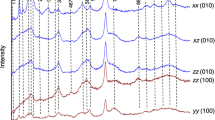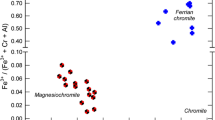Abstract
End-member synthetic fayalite and forsterite and a natural solid-solution crystal of composition (Mg1.80,Fe0.20)SiO4 were investigated using Raman spectroscopy. Polarized single-crystal spectra were measured as a function of temperature. In addition, polycrystalline forsterite and fayalite, isotopically enriched in 26Mg and 57Fe, respectively, were synthesized and their powder spectra measured. The high-wavenumber modes in olivine consist of internal SiO4 vibrations that show little variation upon isotopic substitution. This confirms conclusions from previous spectroscopic studies that showed that the internal SiO4 vibrations have minimal coupling with the lower-wavenumber lattice modes. The lowest wavenumber modes in both forsterite and fayalite shift in energy following isotopic substitution, but with energies less than that which would be associated with pure Mg and Fe translations. The low-wavenumber Raman modes in olivine are best described as lattice modes consisting to a large degree of mixed vibrations of M(2) cation translations and external vibrations of the SiO4 tetrahedra. The single-crystal spectra of forsterite and Fo90Fa10 were recorded at a number of temperatures from room temperature to about 1200 °C. From these data the microscopic Grüneisen parameters for three different A g modes for both compositions were calculated, and also the structural state of the solid solution crystal was investigated. Small discontinuities observed in the wavenumber behavior of a low-energy mixed Mg/T(SiO4) mode between 700 and 1000 °C may be related to minor variations in the Fe–Mg intracrystalline partitioning state in the Fo90Fa10 crystal, but further spectroscopic work is needed to clarify and quantify this issue. The mode wavenumber and intensity behavior of internal SiO4 vibrations as a function of temperature are discussed in terms of crystal field and dynamic splitting and also ν1 and ν3 coupling. Crystal-field splitting increases only very slightly with temperature, whereas dynamical-field splitting is temperature dependent. The degree of ν1–ν3 coupling decreases with increasing temperature.
Similar content being viewed by others
Acknowledgments.
We thank Prof. H. Rager (Marburg) and Dr. F. Wallrafen (Bonn) for the donation of olivine single crystals. This research was made possible by grant I/72 951 from the VolkswagenStiftung. The comments of two reviewers led to changes that improved the manuscript.
Author information
Authors and Affiliations
Corresponding author
Rights and permissions
About this article
Cite this article
Kolesov, B., Geiger, C. A Raman spectroscopic study of Fe–Mg olivines. Phys Chem Minerals 31, 142–154 (2004). https://doi.org/10.1007/s00269-003-0370-y
Received:
Accepted:
Issue Date:
DOI: https://doi.org/10.1007/s00269-003-0370-y




